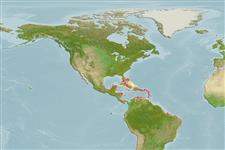Demospongiae |
Chondrillida |
Chondrillidae
Environment: milieu / climate zone / εύρος βάθους / distribution range
Οικολογία
; Υφάλμυρο; εύρος βάθους 1 - 2 m (Αναφ. 86836). Tropical
Western Central Atlantic: Caribbean.
Length at first maturity / Μέγεθος / Weight / Age
Γεννητική Ωρίμανση: Lm ? range ? - ? cm
Chondrilla caribensis f. hermatypica: shiny mustard to greenish yellow; tough encrustations. Chondrilla caribensis f. caribensis: grayish to reddish brown; thickly encrusting; often lobed (Ref. 82089). Grows in any combination of thick encrusting lumps, pillows, low mounds, sheets, or runners. Surface is shiny, smooth and slippery. External color: combination of yellow brown and greenish to dark brown, sides often paler; cryptic specimens completely pale white or tan. Internal color: cream. Tough consistency. Oscules scattered or on top of pillows or mounds; usually small, flush or indented with a collar that may be elevated or indented (Ref. 85482).
Depth range from Belize and Panama (Ref. 86836). Occurs in shallow hard bottoms. Often attaches to seagrass blades, dead finger coral branches, mangrove prop roots and artificial structures (Ref. 85482).
Life cycle and mating behavior
Γεννητική Ωρίμανση | Αναπαραγωγή | Γεννοβολία | Eggs | Γονιμότητα | Larvae
Members of the class Demospongiae are hermaphroditic. Life cycle: The zygote develops into parenchymella larva (free-swimming) before settling down on a substrate where it grows into a young sponge.
Rützler, K., S. Duran and C. Piantoni 2007 Adaptation of reef and mangrove sponges to stress: evidence for ecological speciation exemplified by Chondrilla caribensis new species (Demospongiae, Chondrosida). Mar. Ecol. 28 (Suppl. 1):95-111. (Αναφ. 82089)
IUCN Red List Status
(Αναφ. 130435: Version 2025-1)
CITES status (Αναφ. 108899)
Not Evaluated
Not Evaluated
Threat to humans
Harmless
Human uses
| FishSource |
Εργαλεία
Περισσότερες πληροφορίες
Τροφική ΟικολογίαFood items (preys)
Σύσταση δίαιτας
Κατανάλωση τροφής
Θηρευτές
Population dynamicsΑύξηση
Max. ages / sizes
Length-weight rel.
Length-length rel.
Length-frequencies
Mass conversion
Αφθονία
Life cycleΑναπαραγωγήΓεννητική ΩρίμανσηΓονιμότηταΓεννοβολίαEggsEgg developmentLarvae PhysiologyΚατανάλωση οξυγόνου
Human RelatedStamps, coins, misc.
Διαδικτυακές πηγές
Estimates based on models
Preferred temperature
(Ref.
115969): 25.5 - 28.2, mean 27.2 (based on 367 cells).
